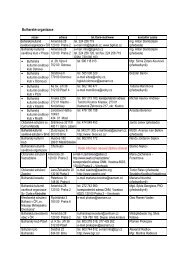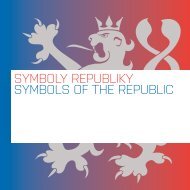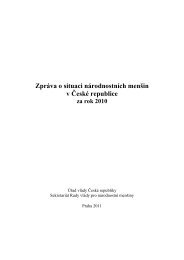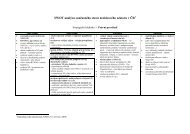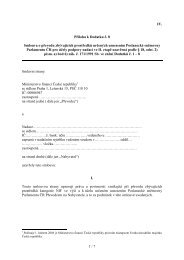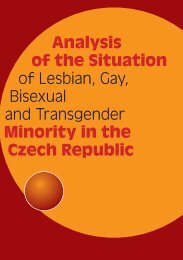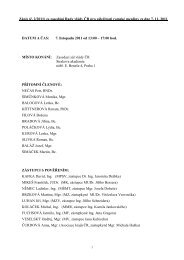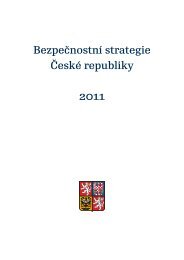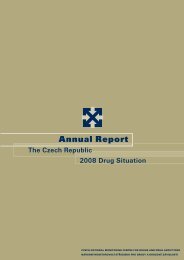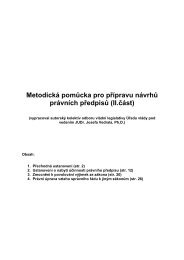The Czech Republic Annual Report 2010 Drug ... - Drogy-info.cz
The Czech Republic Annual Report 2010 Drug ... - Drogy-info.cz
The Czech Republic Annual Report 2010 Drug ... - Drogy-info.cz
Create successful ePaper yourself
Turn your PDF publications into a flip-book with our unique Google optimized e-Paper software.
5 <strong>Drug</strong>-Related Treatment: Treatment Demand and Treatment Availability<br />
<strong>The</strong> number of outpatient facilities providing treatment for drug users in <strong>2010</strong> grew by almost a third; despite this, the<br />
number of outpatients in treatment decreased. This was mainly due to a year-on-year decrease of over 7% in<br />
patients using illegal drugs (excluding alcohol and tobacco). <strong>The</strong>re was also a decline among the three largest<br />
patient groups – those treated for opiate/opioid, stimulant, and polydrug use.<br />
In <strong>2010</strong> two new sobering-up stations were registered to treat acutely intoxicated persons, and this had an impact on<br />
the increase in the number of beds and number of persons admitted.<br />
Once again the number of patients in substitution treatment rose, both in specialised centres and in other medical<br />
practices prescribing buprenorphine products (Subutex ® and Suboxone ® ). Treatment involving these products is still<br />
not fully recorded in the Substitution Treatment Register.<br />
For the first time, data on patient detoxification in inpatient healthcare facilities were collected. It was found that in<br />
<strong>2010</strong>, detoxification units were located in 16 inpatient facilities with 163 dedicated beds, and patients also underwent<br />
detoxification in non-dedicated beds in another 12 facilities. In the reporting year a total of 6,650 persons underwent<br />
addictive substance detoxification, with 3,092 of these persons undergoing detoxification from illicit drugs.<br />
To process hospitalisations in <strong>2010</strong>, the methodology for selecting facilities included under psychiatric inpatient<br />
facilities was changed. Besides psychiatric hospitals and psychiatric wards in general hospitals, data were also<br />
processed for other inpatient facilities that operate inpatient psychiatric wards. In <strong>2010</strong> there was a decrease in the<br />
number of hospitalisations of illicit drug users in these facilities. This decline is attributable to patients hospitalised for<br />
disorders caused by polydrug and opiate/opioid use; the number of hospitalisations for disorders caused by the use<br />
of other (non-cocaine) stimulants increased.<br />
<strong>The</strong> number of drug users in the Public Health Service’s Register of Treatment Demands has risen. In <strong>2010</strong>, a total<br />
of 9,005 drug users sought treatment services, which is about 200 more than in 2009. In comparison with previous<br />
years, the slight downward trend is shifting, bringing the number of treatment demands up to the same levels as in<br />
2004 and 2005.<br />
Treatment demands have long been dominated by stimulant users, the largest group among all those making<br />
treatment demands (62.9%) and among first-time treatment demands (67.5%); the number of pervitin users also<br />
shows the largest year-on-year increase. <strong>The</strong> second largest group is composed of opiate users (23.1%), while<br />
cannabis users were in second place among first-time demands (15.9%); this is unchanged from 2009. In terms of<br />
age structure, a slight aging of the population among those making treatment demands is evident. Although the<br />
average age rose slightly year-on-year, in the medium term there is a clear increasing trend. <strong>The</strong> average age of<br />
those making treatment demands for the first time was 25.7 years and 27.3 years for all demands in <strong>2010</strong>. Over the<br />
past decade, the average age of those making first-time demands and repeat demands has risen by over four years.<br />
Women steadily make up one third of treatment demands. <strong>The</strong> highest relative prevalence and incidence of<br />
treatment demands was recorded in the Ústí nad Labem region and in Prague. <strong>The</strong>se characteristics correspond to<br />
the gender and geographical distribution of problem drug users in the <strong>Czech</strong> <strong>Republic</strong>.<br />
5.1 Strategy/Policy<br />
In <strong>2010</strong> the Government approved the National <strong>Drug</strong> Policy Strategy for the Period <strong>2010</strong>–2018, and in 2011 it<br />
approved the <strong>2010</strong>–2012 Action Plan. Treatment and social reintegration are one of the four pillars of the strategy,<br />
and all four priorities of the action plan concern this area (for more <strong>info</strong>rmation see the chapter on National Action<br />
Plan, Strategy, Evaluation, and Coordination, p. 9). <strong>The</strong> Action Plan defines the following areas of activities for<br />
treatment and social integration:<br />
conceptual definition of the availability and continuity of treatment and after-care programmes for drug users;<br />
the development of special interventions for selected target groups of drug users, including increasing the quality<br />
of substitution treatment for opiate users;<br />
the development of programmes for drug users in prison and keeping these programmes available.<br />
Several healthcare regulations related to the profession of an addictologist and conditions for operating healthcare<br />
facilities focused on addiction treatment were amended in <strong>2010</strong>; see the chapter on Legal Framework (p. 6).<br />
<strong>The</strong> First Faculty of Medicine at Charles University in Prague (Centre for Addictology) offers bachelor’s and master’s<br />
programmes in addictology. An accredited training qualification course called Addictologist consisting of over 900<br />
lessons was opened in September 2011. <strong>The</strong> 2008 and 2009 <strong>Annual</strong> <strong>Report</strong>s provide details on professional<br />
competency and training for practitioners in the field of addictology.<br />
5.2 Treatment System<br />
Treatment and counselling programmes for drug users and addicts and the capacity and occupancy of these<br />
programmes in <strong>2010</strong> are summarised in Table 5-1.<br />
page 55




